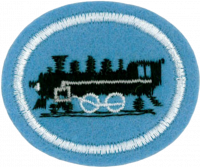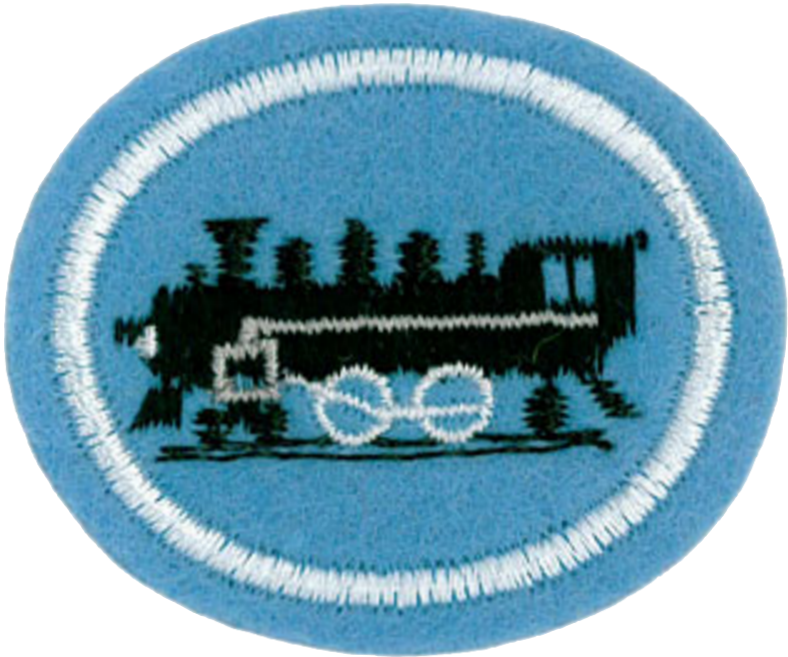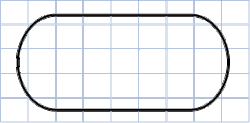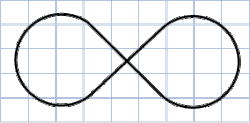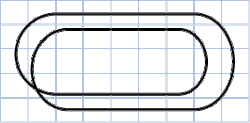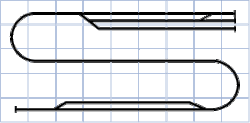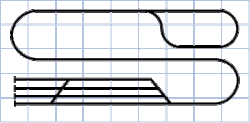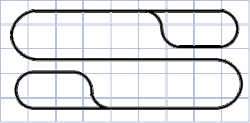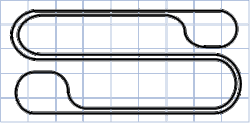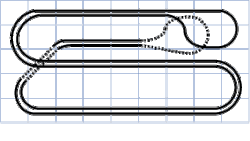Especialidades JA/Trenmodelismo/Respuestas
Nivel de destreza
2
Año
1967
Version
21.12.2025
Autoridad de aprobación
Asociación General
1
2
2a
2b
2c
3
The six most popular scales used are: G scale, Gauge 1, O scale, H0 scale (in Britain, the similarly sized 00 is used), TT scale, and N scale (1:160), although there is growing interest in Z scale. H0 scale is the single most popular scale of model railroad. Popular narrow-gauge scales include HOn3 Scale and Nn3, which are the same scale as HO and N, except with a narrower spacing between the tracks (in these examples, a scale three feet instead of the 4'8.5" standard gauge).
4
Oval
The simplest layout for a model railroad and the starting point for most designs. In this design, two straightaway segments are connected by a semi-circle at each end. This is also the only layout which can easily be created with sectional track without the use of a manufacturer-specific design. Curved sectional track is sold by radii (half the distance across the semi-circle) and a box of such track sections will almost always create exactly half a circle. The two straightaway sections will usually utilize multiple pieces of sectional straight track, as desired by the modeler.
Figure-Eight
The second most common beginner's layout. This layout is best accomplished by purchasing it as a single set or following a manufacturer's layout design using their sectional track. The intersection in the center of the layout can either be accomplished by a piece of crossover track, or by elevating one track over the other. In the latter case, a set of piers or risers will be needed to raise the track at an appropriate rate.
Twice-Around
A modification of the figure-eight, in which one end-loop is contained within the other. The crossover here is not at 90° like in the basic figure-eight example and can be accomplished by using a alternately angled crossover piece or by using elevated track to pass one track over the other. The twice-around layout design allows the train to run continuously for longer than the simple oval before reaching its starting point.
Point-to-Point
This design does not allow a train to run continuously indefinitely, as you might imagine most plans would allow. However, this is the design that most closely resembles real-life railroad operation, since real-life railroads run across country, not in loops or circles. You can construct more elaborate yards at each end in order to enjoy the complexities of real-world operation.
Out-and-Back
This design approximates real-world operation, as each train must make a journey before it returns to the yard from which it originated. Although real freight never returns to its origin the same way it left, this arrangement does allows you to concentrate your time and resources on one yard instead of the two required in a Point-to-Point design (above).
Loop-to-Loop
This design diverges from realistic operation, but does allow the operator to interact with a continuous-running train. A yard can be added in the middle of the layout to simulate freight coming in from each direction. When modeling with two-rail scales, such as HO and smaller, special wiring will be required to insulate each loop from the rest of the line and allow the direction to be reversed on the mainline.
Dog Bone
This design is similar to the loop-to-loop design, but allows for continuous running without intervention from an operator. In addition, the two tracks running side-by-side simulate the double-track lines often seen in real life.
Twisted Dog Bone
This design is adds additional length to the mainline featured in the basic dog-bone design (above). Keeping one or both of the end-loops out of sight allows this layout to very realistically simulate the long distance running of a real railroad.
5
Cleaning & Checking Basic Trackwork
Most model railroads receive power for their electric motors through the tracks they run on. Thus, track must be kept clean and free of even the smallest obstructions. A train running on a dirty track does not operate smoothly or realistically, or may not run at all! The space between rails must also be maintained, though this is more of an issue when individual rails and ties have been laid down by hand. Sectional track usually maintains its proper gauge (space between the rails). Rail cleaning solution can be safely wiped across model track and track-cleaning cars are also available for running around the layout and cleaning hard-to-reach places.
Checking Wheels and Couplers
Locomotives and cars are kept rolling along together by various types of 'couplers.' These can be very tiny on the smaller model railroad scales, but in any case, they must be kept clean and properly hooked together for a train to run along smoothly. Another common problem is derailment when a car's wheels come off the track. This can also be harder to detect on smaller scale trains, but it will eventually get noticed as cars may tip completely off the track. Nevertheless, derailment is the most common operating problem encountered and should be one of the first possibility to check when things are going wrong.
Lubricating Engine Drive Mechanisms
Most model locomotives are powered by electric motors which involve a minimum of moving parts. There are typically tiny gears used in transferring the turning motor's power to the drive wheels of the locomotive. These are easily lubricated with special grease and/or oil available from a hobby supply store. Be careful to follow both the engine and lubricant manufacturers' instructions. Most wheels on other non-powered cars do not need to be oiled or greased except in rare cases.
Detailing Scenes & Structures
Model structures and landscape gather dust, making them look less realistic. These elements of a typical layout should be well anchored with adhesive when they are first installed so that their surfaces can be brushed clean, repainted, re-weathered and even vacuumed. In addition, its fun and rewarding to keep a layout fresh by installing new structures or creating new track-side scenes once your basic modeling is complete.
Testing Electrical Connections
Most model locomotives receive their power from the tracks below through one or more of their wheel sets. Since these wheels are turning, they transmit their power through stationary metal brushes that maintain contact with the tiny axle running between these wheels. These brushes should be kept clean and checked whenever an electrical problem is suspected. In addition, the wires which run from the operator's power pack to the rails themselves can become tangled, shorted out (when they inadvertently touch each other), or disconnected all leading to potential breakdown in the power supplied to the model railroad. A simple electric meter available from a hobby or electronics store can help determine where a breakdown is occurring by testing (1) the output of the power pack directly, (2) the presence of power on the set of tracks where the train is located, or (3) at any control point in between, such as when a control panel switch is used to control power to different track sections.
Adjusting Turnouts, Switch Machines & Ground Throws
Turnouts (sometimes called 'switches') are used to send a train from one set of track to another. These are easy places for trains to become derailed because the wheels must pass over a series of changeable mechanical parts that are more complex than the simple two (or three) rails used elsewhere in the layout. The 'points' of a switch are moved between two different resting positions which determine what path the trail will take after it passes through the turnout. These points must rest securely against either the inside or outside rail and must not move otherwise. If the points are moved remotely, by an electrical signal sent from the control panel to a 'switch machine' next to the turnout, then this switch machine and its associated wiring must be in good working order. If the switch is operated by hand using a small lever or 'ground throw' next to the turnout, then the ground throw needs to be kept clean and lubricated and able to move the points the full distance between their two desired positions.
6
6a
6b
6c
6d
6e
6f
7
7a
7b
7c
7d
7e
7f
A place where two railroad tracks cross each other.
7g
The use of two locomotives to pull an especially long and heavy train.
7h
Part of a railcar's coupling system which allows for some flexing in the tension between cars.
7i
The larger, flat part of a trains wheels that descend below the track's top surface on the inside edge, thus holding the car on the track as it moves.
7j
At the center of a turnout, it is the small X-shaped piece of track that enables a train's wheels to cross over the inside rail.
7k
A space between rails so that they are electrically insulated from one another. This is done so that the two rails do not short together, or so they can be on different circuits.
7l
=
Sometimes used to describe the size of track and cars used on a certain model railroad, it more accurately measures the space between the rails of that railroad's track.
7m
A measurement of the steepness of the track when it is not flat or level with the ground. It is measured in degrees according to its angle from level ground.
7n
A place for storing, sorting or processing train cars which uses track set at an angle with the ground in order to let gravity move cars when needed.
7o
A wheel bearing that has become excessively hot because of friction.
7p
A non-conducting clip, usually made of plastic, that allows two pieces of track to be connected physically while remaining independent electronically. Used between distinct blocks of track.
7q
A bearing in which the shaft between two wheels rotates against the car's truck with the help of lubrication supplied within a journal box, often seen on a train car's trucks.
7r
An arrangement of model railroad track, structures and scenery that models real-life railroad operation in a contained area.
7s
The route a train takes from one destination to another, independent of track used in yards, sidings or spurs.
7t
The real-life railroad operation and equipment upon which a model railroad is based.
7u
A metallic clip placed on the bottom flange at the end of a section of track allowing it to be connected both physically and electrically to the next piece of track on the line.
7v
A length of track which, by use of one or more turnouts, returns a train to its originating position facing the opposite way from which it left.
7w
A section of track that runs parallel to the mainline and allows a train to stop and be passed by another train occupying the same mainline.
7x
A dead-end piece of track which accepts cars to be delivered from the mainline or prepared for shipment to another destination via the mainline.
7y
Something which routes power or trains between two or more options. When routing trains, it is best to use 'turnout' to distinguish the track mechanism from the electronic toggle switch that activates it from the layout's control panel.
7z
Refers in model railroading to the small mechanism attached to a turnout which allows it to be operated by remote-control from the layout's control panel.
7aa
A model railroad truck with its own attached coupler. Although Talgo trucks permit model trains to operate on smaller radius curves, they can be more likely to derail when trains are pushed, rather than pulled.
7bb
A single, solid piece of hardware mounted to the bottom of a railroad car or locomotive to which is attached on or more sets of wheels. On train cars, trucks usually contain two sets of wheels and can swivel beneath the car when the train is navigating a turn.
7cc
A mechanism for allowing a train to leave one set of tracks and join another. Sometimes called a 'switch.'
7dd
A standard of model railroading which does not employ a separate (third) rail for power. Layouts using two-rail modeling systems must employ special wiring when a wye or reverse loop exists within the layout's design.
7ee
A triangle-shaped junction of two railroad lines in which one line joins another with the option of going either direction on the second line.
7ff
A turnout in which both branches leave the turnout at a different angle from the original line. Most turnouts have one straight-through line and a single branch that leaves the line in a different direction.
7gg
A set of tracks which branch off of the mainline and allow train cars to be sorted, reordered or stored while they are en route to their destination.
| For Further Information:
A good glossary of model railroad terms is available under Frequently Asked Questions on the World's Greatest Hobby website A similar list of terms for prototype railroading can be found under Rail Terminology on Wikipedia. |
|---|
8
- a. Ayudar en el montaje del marco exterior
- b. Instalar una sección de basalto
- c. Instalar una sección de vías
- d. Instalar al menos una vuelta, incluido el cableado
- e. Ayudar en la construcción del paisaje como árboles, rocas, montañas o el césped
- f. Hacer un modelo de edificio o estructura del tren
- g. Asistir en el cableado para el suministro de energía eléctrica a las vías
You can do this on your own, or as part of a club (either a group of Pathfinders earning the honor together, or as part of a model railroading club). Because there are a lot of requirements to meet here, it would be a good idea to make a checklist so you can be sure you have met each.
9
Once you have built (or have helped build) a model set, how can you pass up the opportunity to operate it? In reality, the set will be operated several times during construction to test each new addition. If possible, why not transport the setup to your church for Pathfinder Sabbath?
